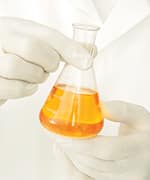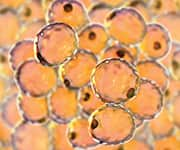LIFE EXTENSION MAGAZINE
Prescription drugs that enable massive weight loss made headline news this year.1
Yet people seeking modest weight loss often turn to plant-based alternatives that are backed by human research.
In a placebo-controlled study, both groups were asked to continue their existing diet and exercise habits.
The group ingesting a new fruit extract lost more total body weight than the placebo arm.2
The fruit extract group also reduced waist circumference by 2.8 inches.2
This article describes research supporting the use of this fruit that originated in the Mediterranean.
Dangers of Abdominal Fat
More than 70% of U.S. adults are overweight or obese.3
But not all body fat is the same. Certain types, such as abdominal fat, pose the greatest threat.
Excess body weight around the abdomen, or abdominal obesity, keeps our bodies in an inflammatory state that has been associated with increased risk of metabolic abnormalities.4
A review paper published in the Archives of Medical Science concluded that:5
"Sustained inflammation is considered a strong risk factor for developing many diseases including CVDs [cardiovascular diseases], metabolic syndrome, diabetes, and cancer."
Readers of this publication have been educated for decades about the dangers of chronic inflammation and strategies to combat it.
The "Moro Orange"
Searching for a way to promote healthy weight loss, scientists have investigated compounds known as anthocyanins.
Evidence from preclinical studies suggests that diets enriched in anthocyanins can improve glucose tolerance and insulin sensitivity.5
Anthoncyanins are pigments found in red, blue, and purple color fruits and in the "moro orange."5
The moro orange fruit is believed to have originated at the beginning of the 19th century in Sicily, as a result of a natural bud interaction with another orange type.5
Anthocyanins from moro oranges have been shown to help decrease weight and adipose tissue (fat) by regulating metabolism of fatty acids.7
One study showed that when healthy, overweight adults supplemented with a moro orange juice extract rich in anthocyanins it resulted in significant reductions in body mass index (BMI) compared with taking a placebo.3
Beneficial Compounds in Moro Orange
Scientists have concluded that the anti-obesity effect of moro orange juice in animal studies is so significant, it cannot be explained by anthocyanin content alone.
Moro orange contains other health-promoting compounds, including:6
- Flavonoids
- Carotenoids
- Hydroxycinnamic acids
These and other moro orange components may work together to inhibit fat storage.6
Research on mice demonstrated that intake of moro orange juice:8
- Reduced fat accumulation by about 50%,
- Decreased adipocyte size, and
- Regulated gene expression of adipose tissue (modulated gene expression changes caused by a high-fat diet).
What you need to know
Weight-Loss Benefits of Moro Orange
- Clinical studies show that moro orange extract can reduce weight by an average of 4.2% and decrease dangerous belly fat, when combined with exercise and a reduced-calorie diet.
- Moro orange is high in anthocyanins, which some data have linked to weight loss, along with an array of other beneficial compounds.
Weight Loss in Humans
Scientists set out to assess moro orange's potential for weight loss in humans.
In a clinical study, researchers instructed 60 overweight individuals to take 400 mg of moro orange juice extract once daily. They were also asked to continue with their existing diet and exercise habits.2
Compared to placebo, those who took the moro orange extract for 12 weeks reduced their:
- Weight by 4% (vs. 0.5% with placebo),
- BMI by 1.11 kg/m2 (vs. 0.15 kg/m2 with placebo),
- Waist circumference by 2.79 inches (vs. 0.31 inches with placebo), and
- Hip circumference by 2.35 inches (vs. 0.27 inches with placebo).
Losing Weight and Fat
For greater validation, a clinical trial was designed that involved 136 overweight but healthy humans, followed for a longer period of six months.9
This time, the volunteers were asked to consume 500 fewer calories daily and walk for 30 minutes, three times a week.
Those who took 400 mg of moro orange extract once daily, on average reduced:9
- Weight by 4.2% (vs. 2.2% with placebo),
- BMI by 1.2 kg/m2 (vs. 0.6 kg/m2 with placebo),
- Waist circumference by 1.5 inches (vs. 0.7 inches with placebo),
- Fat mass by 7.5% (vs. 5.7% with placebo),
- Abdominal fat mass by 11.3% (vs. 6.1% with placebo),
- Visceral fat mass (between abdominal organs) by 12.4% (vs. 9.0% with placebo), and
- Subcutaneous fat mass (just under the skin) by 9.4% (vs. 6.4% with placebo).
Overall, 36% of those in the moro orange group had a weight loss of more than 5%, compared to 22.5% of the placebo group.9
To put the waist-size reduction of 1.5 inches into perspective, the notches on a belt are usually about one inch apart, making this a reduction of well more than one belt notch.
Evidence is clear that moro orange extract can be a vital part of a healthy weight-loss program.
Summary
The moro orange has been found to help reduce weight and dangerous abdominal fat.
It is high in anthocyanins and other compounds that may work together to promote weight loss.
Human studies found that moro orange extract safely reduced waist circumference by 1.5 to 2.79 inches.
If you have any questions on the scientific content of this article, please call a Life Extension Wellness Specialist at 1-866-864-3027.
References
- Jastreboff AM, Aronne LJ, Ahmad NN, et al. Tirzepatide Once Weekly for the Treatment of Obesity. N Engl J Med. 2022 Jun 4.
- Cardile V, Graziano AC, Venditti A. Clinical evaluation of Moro (Citrus sinensis (L.) Osbeck) orange juice supplementation for the weight management. Nat Prod Res. 2015;29(23):2256-60.
- Available at: https://www.cdc.gov/nchs/fastats/obesity-overweight.htm . Accessed November 2, 2023.
- Kolb H. Obese visceral fat tissue inflammation: from protective to detrimental? BMC Medicine. 2022 2022/12/27;20(1):494.
- Ellulu MS, Patimah I, Khaza'ai H, et al. Obesity and inflammation: the linking mechanism and the complications. Arch Med Sci. 2017 Jun;13(4):851-63.
- Azzini E, Giacometti J, Russo GL. Antiobesity Effects of Anthocyanins in Preclinical and Clinical Studies. Oxid Med Cell Longev. 2017;2017:2740364.
- Grosso G, Galvano F, Mistretta A, et al. Red orange: experimental models and epidemiological evidence of its benefits on human health. Oxid Med Cell Longev. 2013 2013/05/02;2013:157240.
- de Lima LP, de Paula Barbosa A. A review of the lipolytic effects and the reduction of abdominal fat from bioactive compounds and moro orange extracts. Heliyon. 2021 Aug;7(8):e07695.
- Titta L, Trinei M, Stendardo M, et al. Blood orange juice inhibits fat accumulation in mice. Int J Obes (Lond). 2010 Mar;34(3):578-88.
- Briskey D, Malfa GA, Rao A. Effectiveness of Moro Blood Orange Citrus sinensis Osbeck (Rutaceae) Standardized Extract on Weight Loss in Overweight but Otherwise Healthy Men and Women-A Randomized Double-Blind Placebo-Controlled Study. Nutrients. 2022;14(3):427.







